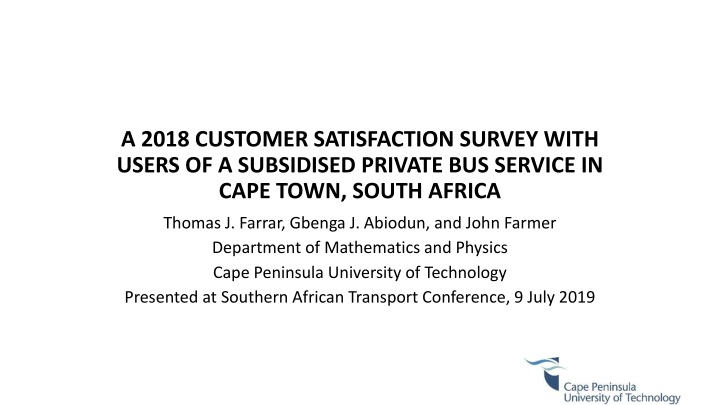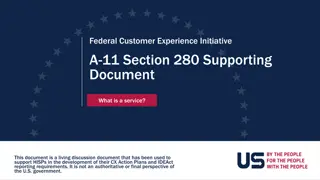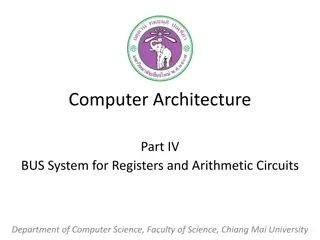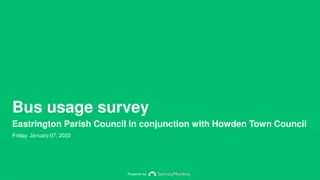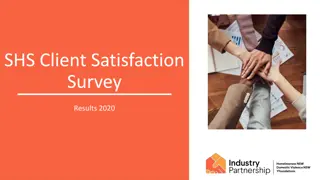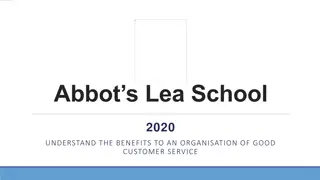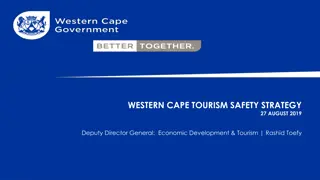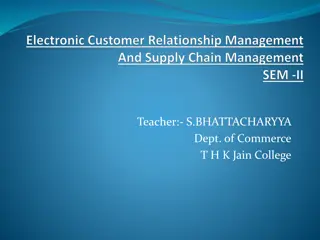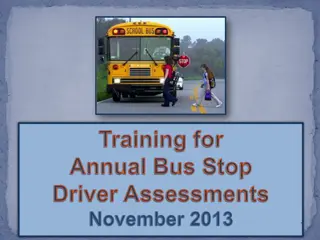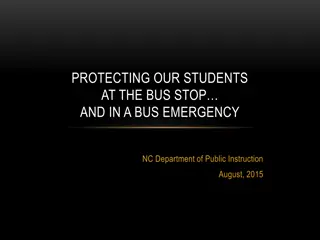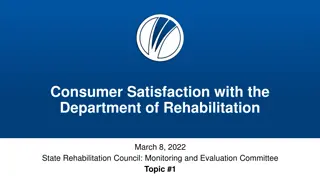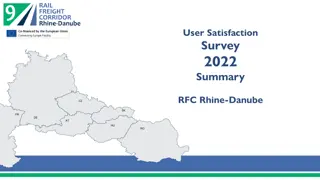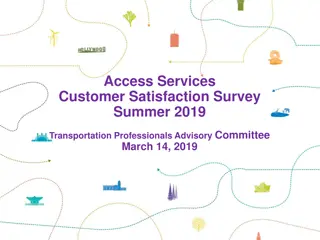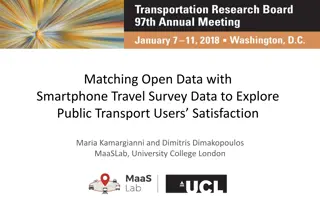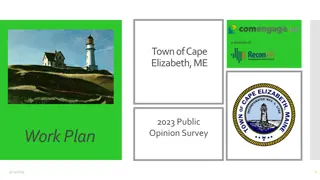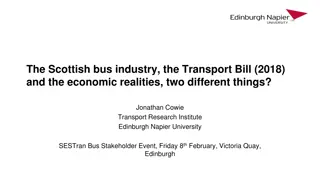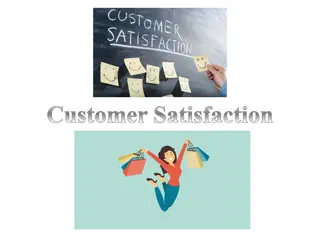Customer Satisfaction Survey with Users of Subsidised Private Bus Service in Cape Town, 2018
This study presents a customer satisfaction survey conducted in 2018 with users of a subsidised private bus service in Cape Town, South Africa. The research, carried out independently by Cape Peninsula University of Technology researchers, aimed to measure and assess customer satisfaction with Golden Arrow Bus Services (GABS). The study provides insights into service quality in public transport and the demographics and service usage profiles of GABS customers. The findings offer valuable information for both the bus service operator and wider society.
Download Presentation

Please find below an Image/Link to download the presentation.
The content on the website is provided AS IS for your information and personal use only. It may not be sold, licensed, or shared on other websites without obtaining consent from the author.If you encounter any issues during the download, it is possible that the publisher has removed the file from their server.
You are allowed to download the files provided on this website for personal or commercial use, subject to the condition that they are used lawfully. All files are the property of their respective owners.
The content on the website is provided AS IS for your information and personal use only. It may not be sold, licensed, or shared on other websites without obtaining consent from the author.
E N D
Presentation Transcript
A 2018 CUSTOMER SATISFACTION SURVEY WITH USERS OF A SUBSIDISED PRIVATE BUS SERVICE IN CAPE TOWN, SOUTH AFRICA Thomas J. Farrar, Gbenga J. Abiodun, and John Farmer Department of Mathematics and Physics Cape Peninsula University of Technology Presented at Southern African Transport Conference, 9 July 2019
Disclaimer This study was a contract research project commissioned and funded by Golden Arrow Bus Services However, the CPUT researchers exercised complete autonomy in research design and data collection and analysis A technical report (c. 120 pages) was produced The contract between GABS and CPUT allowed for use of data for research publication subject to permission from GABS, which permission has been duly granted
Contents Introduction Methodology Results Conclusion
Background Golden Arrow Bus Services (Pty) Ltd. (GABS) is largest private bus company in WC Fleet of 1040 buses Operates over 3100 routes Approximately 220 000 passengers served daily GABS operates a subsidised service in Cape Town Metropolitan Municipality under a contract with WC Dept of Transport Since 2012, GABS has contracted CPUT to independently assess service quality via a biennial customer satisfaction survey This study concerns the 2018 iteration of this survey
Service quality in public transport is a matter of great importance to users, operators, and wider society (Eboli & Mazzulla 2008) Many large public transport operators use quality control systems that feature customer satisfaction surveys (Tyrinopoulos & Aifadopoulou 2008) In Cape Town context, service quality evaluations are relevant to the planned change from interim to tendered contracts (Transport and Urban Development Authority, 2013; 2018)
Aims of Research Primary Aims To develop a tool for comprehensive measurement of customer satisfaction with bus services in a South African context To use this tool to assess customer satisfaction with GABS in 2018 Secondary Aims To obtain a profile of GABS customers in terms of demographics and service usage
Scope of Research Geographical scope is Cape Town Metropolitan Municipality (area of GABS operations) Customers approached and interviewed at GABS termini Data collection was originally planned for May 2018 but postponed due to national bus strike Data collection occurred during peak hours of a five-day work week, 10-14 September 2018
Literature Review A comprehensive review of literature on perceived service quality and customer satisfaction, especially in public transport context, was undertaken This review informed design of the survey instrument (questionnaire) More details can be found in the accompanying Conference Proceedings publication
Questionnaire Design GABS customer satisfaction survey questionnaire has evolved over its iterations (2012, 2014, 2016, 2018) Goal of continual improvement is balanced against goal of comparability of results across years 2018 questionnaire was eight A4 pages long and trilingual (English, IsiXhosa, Afrikaans) Standard recruitment script was used with three screening questions to exclude ineligible participants Age < 12; not GABS customer; had already participated
20 Perceived Service Quality Items Affordability of Fares Distances you must walk to reach bus stop or terminus Reliability of buses not to break down Driving ability of bus drivers Waiting time at bus stop/terminus Travel time after boarding the bus Timetable (hours when bus service is available) Condition of bus stops/shelters Temperature level inside bus Levels of noise and vibration on bus Range of routes available Availability of route and timetable information Levels of crowding on bus Other passengers behaviour on bus Convenience of fare payment system Ease of getting on and off bus Level of safety from traffic accidents Level of safety from crime at bus stops and terminals and on bus Attractiveness and cleanliness of buses Helpfulness of Staff
How satisfied are you with this part of the service? Very satisfied 5 4 3 2 1 Very dissatisfied Has this part of the service given you any problem recently (within the last 30 days)? No Yes
Customers were also asked to rate their overall satisfaction with the service on a scale from 1 to 10 Various questions about demographic characteristics and current and future use of services were also included
Importance Measurement To enable Importance-Performance Analysis (IPA) one needs to measure both performance and importance The measurement of importance has been a particular methodological challenge; three distinct approaches have been used and all have shortcomings Approach 1 (2012): Ask customers to rank the three items most important to them (shortcoming: recency effect and other biases) Approach 2 (2014, 2016): Ask customers to rate importance of each item on five-point scale (shortcoming: most customers give every item a 5!) Approach 3 (2018): Gap score technique (shortcoming: importance scores not independent of performance scores)
Gap Score Technique For each item, calculate average overall satisfaction score (on 10- point scale) for customers who did not and who did experience a recent problem with this service aspect Gap score is difference in these two average satisfaction scores; the larger the gap, the more important the item is
Sampling Methodology Two-stage cluster sampling was used to draw a representative sample of GABS customers First stage: sampling of six GABS termini (three sampled purposively due to large size; other three sampled randomly) Second stage: selection of individual customers passing through these termini during peak hours (06:00-09:30, 15:00-18:30) Enumerators consisted of 48 CPUT Mathematical Sciences students; received a full day of training Pilot survey conducted to test out questionnaire, logistics and provide enumerators with practice Target sample size was 2500; actual sample size 2677 of which 187 incomplete
Data Capturing Methodology Student data capturers entered data in MS Excel templates Duplicate data entry was used to minimise data capturing errors
Ethical Considerations Research protocol was approved by a Research Ethics Committee (REC) at Cape Peninsula University of Technology Informed consent was obtained orally and information sheet provided to each participant including contact details for REC in case of grievance
Data Analysis Data analysis conducted using R statistical software (R Core Team 2018)
Demographic Profile Majority (56%) of customers are female Median age of customers is in low 30s Nearly all customers self-identify as Black African (60%) or Coloured (37%) Majority of customers (68%) are not currently studying; 15% are studying at secondary level; 16% at tertiary level Most common highest education level among customers is matric (39%) Most customers (68%) are currently working
6% of customers indicate they are living with a disability 26% of customers have driver s license Majority (54%) of customers households own no vehicle Household income and transport expenditure results are of doubtful reliability due to high non-response rates Mean monthly household take-home income estimated at about R7000 (non- response rate: 72%) Mean monthly household transport expenditure estimated at about R700 (non-response rate: 52%)
Service Usage Results Majority (59%) of customers have been using GABS for five years or less Majority (72%) of customers typically purchase weekly ticket Median duration of trip for commuting users is 45-60 minutes 85% certainly intend to continue using GABS in future 91% use GABS at least 4 days/week Most common other transport modes used by customers are taxis and private vehicles; very little overlap with train or MyCiti services
Perceived Service Quality Results PSQ index score between 0 to 80 obtained by aggregating scores (from 0 to 4) on 20 individual items Mean PSQ index score was 52.5, indicating moderately high overall satisfaction Cronbach s Alpha for index was 0.84; acceptable internal consistency Direct measurement of overall satisfaction on 1-to-10 scale yielded average score of 7.2 Items with three highest satisfaction scores were Ease of getting on and off bus, Driving ability of drivers, and Reliability of buses not to break down Items with three lowest satisfaction scores were Condition of bus stops/shelters, Level of safety from crime at bus stops, terminals and on bus, and Level of crowding on buses
Items with highest gap scores were Helpfulness of Staff, Affordability of Fares, and Reliability of Buses not to Break Down Items with lowest gap scores were Condition of bus stops/shelters, Level of safety from crime at bus stops and terminals and on bus, and Distances you must walk to reach bus stop or terminus It seems counterintuitive to conclude that the latter items are unimportant to customers It also conflicts with qualitative data collected (customer comments) suggesting safety from crime is a major customer concern This calls into question effectiveness of gap score technique as importance measure
Relationships between PSQ and Service Usage Kendall s nonparametric correlation method was used to test for associations between PSQ index score and service usage variables Statistically significant findings included the following: PSQ index score correlates positively with intention to continue using GABS PSQ index score correlates negatively with frequency of taxi use PSQ index scores correlates negatively with duration of usual bus trip
Conclusion The study achieved its primary and secondary aims of comprehensively measuring GABS customer satisfaction, demographic characteristics and service usage characteristics PSQ index appears to be a reliable and appropriate tool for measuring customer satisfaction with bus transport in a South African context Survey results suggest that most customers are reasonably satisfied with GABS and intend to continue using the service Some areas of concern were identified using satisfaction metric and gap score A better way of measuring relative importance of items is needed
References See full reference list in accompanying conference proceedings publication
